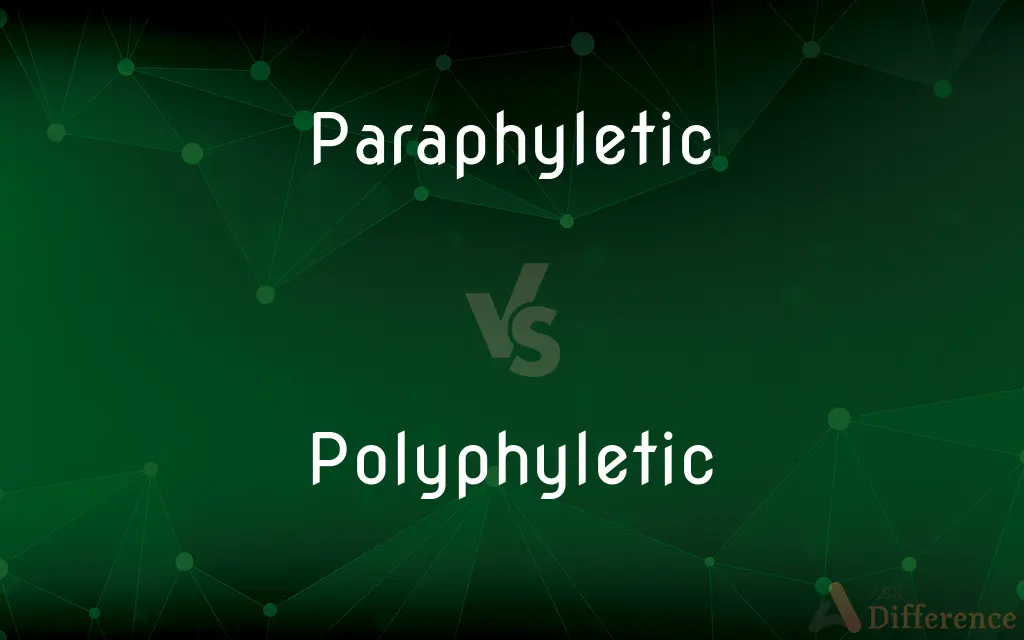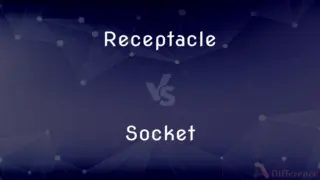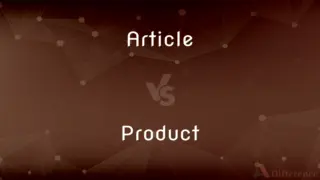Paraphyletic vs. Polyphyletic — What's the Difference?
By Tayyaba Rehman & Fiza Rafique — Updated on March 9, 2024
Paraphyletic groups include a common ancestor and some, but not all, descendants, while polyphyletic groups exclude the common ancestor.

Difference Between Paraphyletic and Polyphyletic
Table of Contents
ADVERTISEMENT
Key Differences
Paraphyletic groups are defined by the inclusion of a common ancestor and some, but not all, of its descendants, making the group somewhat incomplete from an evolutionary perspective, whereas polyphyletic groups consist of various organisms that do not share an immediate common ancestor within the group, often grouped together based on similar features that evolved independently.
In a paraphyletic group, members are more closely related to each other than to any outside the group due to a shared common ancestor, even if not all descendants are included. In contrast, polyphyletic groups might include species that appear similar due to convergent evolution but are genetically and evolutionarily distinct.
The concept of a paraphyletic group often arises when a single lineage within a larger group evolves significantly different traits, leading to its classification as a separate group, thereby making the original group paraphyletic. On the other hand, polyphyletic groups are often identified by shared characteristics that are not inherited from a common ancestor within the group, but rather due to similar selective pressures causing convergent evolution.
Paraphyletic groupings can lead to more natural and evolutionary meaningful classifications in some contexts by highlighting transitional forms and evolutionary pathways, whereas polyphyletic groupings can be misleading by grouping together organisms that do not share a recent common ancestor, potentially obscuring true evolutionary relationships.
While paraphyly is often seen as a byproduct of evolutionary processes where not all descendants of a common ancestor are similar enough to be grouped together, polyphyly is usually the result of convergent evolution where unrelated lineages develop similar traits independently, making polyphyletic groups less cohesive from an evolutionary standpoint.
ADVERTISEMENT
Comparison Chart
Common Ancestor
Includes common ancestor and some descendants.
Excludes common ancestor.
Evolutionary Relationship
More closely related due to shared ancestry.
Less related, grouped by convergent traits.
Group Cohesion
More cohesive, excluding some descendants.
Less cohesive, based on independent traits.
Result of
Exclusion of some descendants due to different traits.
Convergent evolution.
Classification Utility
Highlights evolutionary transitions.
Can obscure true evolutionary relationships.
Compare with Definitions
Paraphyletic
Grouped by direct lineage, excluding some members.
Amphibians excluding some modern forms.
Polyphyletic
Groups based on similar traits, not common ancestry.
Flying animals like bats and birds.
Paraphyletic
Includes a common ancestor and some descendants.
Reptiles excluding birds.
Polyphyletic
Can be misleading in evolutionary context.
Grouping winged insects and birds due to flight.
Paraphyletic
Shows evolutionary pathways and transitions.
Fish excluding tetrapods to show transition to land.
Polyphyletic
Lacks a single recent common ancestor within the group.
Marine mammals from different lineages.
Paraphyletic
Defined by evolutionary lineage with missing branches.
Jawed vertebrates excluding mammals and birds.
Polyphyletic
Often revised as understanding of evolutionary relationships improves.
Groupings based on outdated traits.
Paraphyletic
Reflects an incomplete clade in phylogenetic trees.
The class Reptilia when birds are excluded.
Polyphyletic
Formed through convergent evolution.
Cacti in the Americas and some African succulents.
Paraphyletic
Of or relating to a group of taxa that includes the common ancestor of all the members but not all descendants of that ancestor.
Polyphyletic
Of or relating to a group of taxa that does not include the common ancestor of all the members.
Paraphyletic
(systematics) Of a defined group of taxa, not including all descendants of the most recent common ancestor of all members.
Polyphyletic
Of or derived from more than one stock or source.
Polyphyletic
(taxonomy) Having multiple ancestral sources; referring to a taxon that does not contain the most recent common ancestor of its members.
Polyphyletic
Pertaining to, or characterized by, descent from more than one root form, or from many different root forms; polygenetic; - opposed to monophyletic.
Common Curiosities
Can paraphyletic groups lead to confusion?
Yes, they can be confusing by excluding some descendants, which might suggest an incomplete understanding of evolutionary relationships.
How does convergent evolution relate to polyphyletic groups?
Convergent evolution is a key factor in the formation of polyphyletic groups, as it leads to similar traits in unrelated lineages.
How do polyphyletic groups arise?
Polyphyletic groups often arise from convergent evolution, where unrelated species develop similar traits independently.
Can a group be both paraphyletic and polyphyletic?
No, because paraphyletic groups include a common ancestor and some descendants, while polyphyletic groups do not include a common ancestor.
What is an example of a paraphyletic group in animals?
Reptiles excluding birds are often considered a paraphyletic group.
What is a polyphyletic group?
A polyphyletic group consists of species from different lineages grouped together based on similar features, not a common ancestor.
Are polyphyletic groups accepted in modern taxonomy?
Polyphyletic groups are generally discouraged in modern taxonomy because they can obscure true evolutionary relationships.
How do evolutionary biologists identify paraphyletic groups?
Through phylogenetic analysis and understanding the evolutionary history of organisms.
Why are paraphyletic groups significant in evolution?
They highlight evolutionary transitions and the divergent evolution of lineages from a common ancestor.
What role does genetic analysis play in determining these groups?
Genetic analysis is crucial in identifying true evolutionary relationships, helping to clarify whether groups are paraphyletic or polyphyletic.
What defines a paraphyletic group?
A paraphyletic group includes a common ancestor and some, but not all, of its descendants.
Can the classification of a group change from polyphyletic to paraphyletic?
Yes, as our understanding of evolutionary relationships improves, classifications can change.
Do paraphyletic groups have any practical use?
They can be useful in understanding evolutionary processes and transitional forms.
Can plants have paraphyletic or polyphyletic groups?
Yes, plants can also be classified into paraphyletic or polyphyletic groups based on their evolutionary relationships.
Why are polyphyletic groups often revised in scientific literature?
As more is learned about the evolutionary history of organisms, polyphyletic groups may be revised to more accurately reflect these relationships.
Share Your Discovery

Previous Comparison
Receptacle vs. Socket
Next Comparison
Article vs. ProductAuthor Spotlight
Written by
Tayyaba RehmanTayyaba Rehman is a distinguished writer, currently serving as a primary contributor to askdifference.com. As a researcher in semantics and etymology, Tayyaba's passion for the complexity of languages and their distinctions has found a perfect home on the platform. Tayyaba delves into the intricacies of language, distinguishing between commonly confused words and phrases, thereby providing clarity for readers worldwide.
Co-written by
Fiza RafiqueFiza Rafique is a skilled content writer at AskDifference.com, where she meticulously refines and enhances written pieces. Drawing from her vast editorial expertise, Fiza ensures clarity, accuracy, and precision in every article. Passionate about language, she continually seeks to elevate the quality of content for readers worldwide.














































